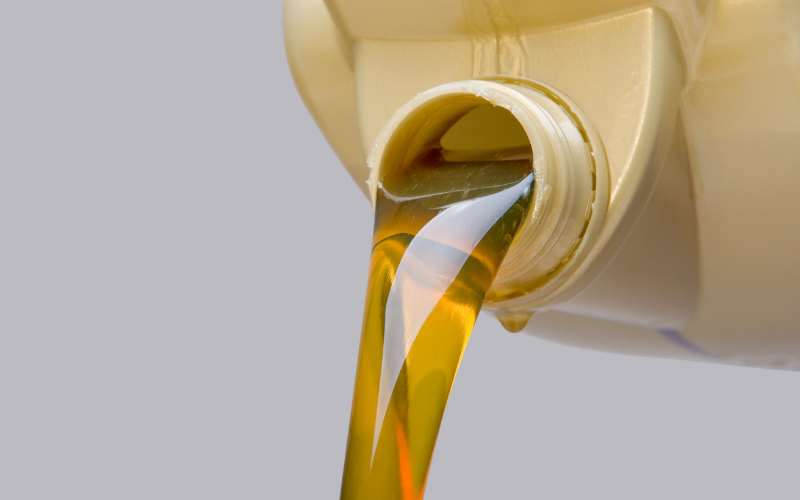Oil is the lifeblood of the engine and when changing it out or topping it off, you want to be sure that you’re using the right kind. This is where the oil grading system comes in.
Although it might seem confusing at first, there is a pretty clear pattern that the Society of Automotive Engineers (SAE) follows when categorizing motor oil.
To grade oil, the viscosity/weight (how easily the oil can flow), is used. The ratings go from 0-60 with the lowest numbers representing the thinnest (least viscous) and the highest numbers representing the thickest (most viscous) oils.
The question of SAE 30 vs 5w30 might seem to be confusing since they have one of the same ratings, but they’re actually a bit different.
SAE 30 vs 5w30 (The Short Version)
Basically, SAE 30 and 5w30 have the same rating or viscosity of 30 while hot, but when cold their ratings differ.
Because of this, they have slightly different uses: SAE 30 is the most common small engine oil, and 5w30 is used mostly in the automotive industry.
Since it is a multi-grade oil, 5w30 can handle very cold conditions which makes it good for cars, but not always necessary for lawn mowers.
Is SAE 30 the Same as 5w30?
To be clear, SAE 30 and 5w30 are not the same. SAE 30 is a single-grade oil meaning it is only rated one time at a very high temperature. This high-temperature rating is right in the middle at 30.
5w30 on the other hand, is a multi-grade oil that has two ratings. Meaning at high temperatures it is also rated at 30, but at low temperatures, it has a rating of 5. This low-temperature grade is marked by a “w” representing a winter rating.
These are the technical differences but I’ll talk more about the traits and uses of each in the next sections.
The Characteristics of SAE 30 and Its Benefits
- High quality SAE30 oil
- Specially formulated for higher operating temperatures of air cooled engines
- This OEM oil ensures proper fit and performance to maintain the life of your Briggs and Stratton equipment
Last update on 2025-06-20 // Source: Amazon Affiliates
As I mentioned above, SAE 30 is the traditional small engine oil. Since it’s a single-grade oil, it’s fairly simple and inexpensive.
For lawn mowers, SAE 30 has been a trusted grade for a long time because it functions really well in the temperature range where most mowers are used.
Since cold-starts and operating under very cold conditions usually aren’t concerns when it comes to grass cutting, SAE 30 is usually a great option.
For snow blowers, on the other hand, SAE 30 might not be ideal. With temperatures closer to freezing, multi-grade oils have the upper hand.
The Characteristics of 5w30 and Its Benefits
- 100% Synthetic SAE 5W-30
- For Use In All Air Cooled 4-cycle Engines
- 32 Oz. bottle
Last update on 2025-06-20 // Source: Amazon Affiliates
With a very low winter rating, 5w30 oil can hold up against some extremely cold temperatures. This is a really useful trait especially when it comes to cars, airplanes, and other machinery that works hard all winter.
Maintaining a good viscosity at low temperatures, 5w30 is a great help to freezing cold engines that are trying to get started.
Since the majority of mowing is done in warmer weather, this oil grade is not widely used in lawn mowers.
Still, that doesn’t mean that you can’t use it in your mower.
Frequently Asked Questions About These Oils
With a combination of numbers and letters defining all these types of oil, there are a lot of really common questions about the use and properties of one oil compared to another.
Below are two of the most common ones when it comes to SAE 30 and 5w30. Let me try to give a clear answer to both.
Can I Use SAE 5w30 in My Lawn Mower?
Yes, you can use SAE 5w30 in your lawn mower, but should you? My advice would be to avoid using 5w30 in your lawn mower unless you’re going to be dealing with some pretty cold conditions.
If you’re not quite sure about 5w30 but you would like to use a multi-grade oil in your mower, you could compare SAE 30 vs 10w30 too.
If you’re still unsure, Briggs & Stratton made a super useful oil finder tool that will give you a general idea about the best oil to use (even if you don’t have one of their engines).
Can I Use SAE 30 Instead of 5w30 in My Mower?
In most cases with a lawn mower engine, you’ll be fine using SAE 30 vs 5w30. But, there are three things you should take into consideration though.
First, how new is your mower? Some newer lawn mowers have been designed with multi-grade oil in mind, and the manufacturer may recommend using 5w30 over SAE 30.
This brings me to the next point: check the manufacturer’s guidelines. It might be a pain to dig them up, but it’s worthwhile research.
Lastly, think about the weather where you live. If it doesn’t get very cold (anywhere near freezing) then you should be totally fine with SAE 30.



I had a problem choosing the oil for my Briggs lawn mower; thank you very much for the enlightenment. Keep up your missionary work. Anthony from Malta
Lower numbers thickest!!!???? I believe you have that backwards!!!
Hi Bill!
Whoops… that was a big typo. You’re absolutely right, oils with a lower viscosity rating are thinner (less viscous). Thanks for pointing that out!
Appreciate it 🙂
Tom.